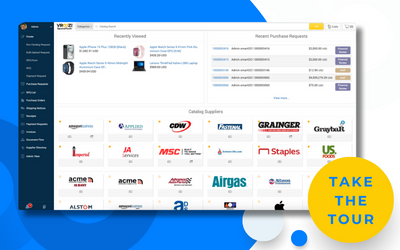The path from procurement to payment is often fraught with inefficiencies, delays, and potential pitfalls. Lack of integration leads to bottlenecks and miscommunications. Outdated manual processes result in errors and time-consuming, repetitive work (and rework). Complex requisition and approval workflows prolong the purchase cycle.
Procure-to-pay (P2P) automation helps businesses overcome these challenges with integration technology, intuitive interfaces, and collaboration solutions to streamline the entire procurement process. The result is more efficient, accurate, and transparent procurement and accounts payable operations.
Just as important, automation substantially reduces the cost of procurement: the Hackett Group found that digital transformation saved businesses 45% and more on procurement costs. Businesses that automate invoicing see substantial cost reductions: up to $40 per invoice for manual processing to less than $4 for automatic processing, in some cases.
In this article, we explore the procure-to-pay process, the challenges of traditional procurement practices, and how automation can transform this crucial aspect of business operations.
Procure-to-Pay Process Fundamentals
Procure-to-pay, sometimes called purchase-to-pay and often abbreviated P2P, encompasses the entire procurement process within a business. P2P crosses traditional departmental boundaries to include both procurement and accounts payable functions.
P2P is typically divided into several key stages. Each stage is integral to the overall efficiency and effectiveness of procurement operations. Let’s take a look at these stages to better understand the procure-to-pay cycle before exploring how it can be streamlined and integrated with P2P automation.
Demand
The need for a specific product or service is identified within the organization. It could be a demand for office supplies, machinery parts, or professional services — whatever an employee or procurement professional thinks the company needs. The demand stage is crucial because it shapes the entire journey, determining what will be procured, in what quantity, and the timeframe for acquisition.
Purchasing
The purchasing process involves sourcing and selecting a supplier for the needed goods or services. If the need is newly identified, purchasing may include supplier evaluation, negotiation of terms, and finalizing contracts. However, a company will often expect employees to purchase products from preferred suppliers with pre-negotiated contracts.
Requisition
The employee makes a formal request for the procurement of the identified goods or services. The request, often in the form of a purchase requisition or a requisition form, is usually submitted to the procurement department or a manager for review and approval.
Purchase Order Creation
Once the purchase requisition is approved, a purchase order (PO) is generated and sent to the supplier. A purchase order is a legal document outlining the order’s details, including items or services being purchased, quantities, and agreed-upon prices.
Order Acknowledgement
The supplier confirms receipt and acceptance of the PO. Order acknowledgment often confirms what has been ordered, quantities, prices, and a delivery schedule. Acknowledgment is an essential step as it prevents any miscommunication or misunderstanding about the order details.
It also provides an opportunity to discuss the order with the supplier if the buyer’s needs have changed or the supplier’s terms are unacceptable.
Receipt of Goods and Services
Upon delivery of the goods or services, they are inspected to ensure they match the order and meet the expected quality standards. Any discrepancies are noted and resolved at this stage. A receiving report may be created to confirm that the goods were received in the agreed-upon conditions and quantities.
Invoice Processing
The supplier sends an invoice and the organization verifies it against the PO (in two-way matching) or the PO and receiving report (in three-way matching). Any discrepancies are addressed before the invoice is approved for payment.
Payment
Once the invoice is approved, payment is processed and sent to the supplier, completing the procure-to-pay cycle.
Clearing the Path: Understanding Roadblocks in the Procurement Cycle
Procurement is integral to your business’s operations, but traditional procurement solutions often limit a business’s ability to seamlessly move through the stages discussed in the previous section. The result is operational and financial inefficiency.
Understanding these challenges is the first step toward automating procure-to-pay processes and enhancing the overall efficacy of the procurement function.
Rogue Spending
Rogue spending occurs when employees purchase outside of agreed-upon contracts or approved supplier lists. When employees bypass approved suppliers, the result is typically increased cost, lost savings opportunities, and an inability to take advantage of negotiated supplier discounts.
Tail spend is a similar phenomenon that covers the large number of low-value transactions that are not managed within the business’s procurement processes. Individually, these purchases are small but taken together, they combine to substantial unmanaged value.
Non-Compliance With Procurement Policies
Organizations establish procurement policies to streamline purchasing, ensure fair dealings, and comply with legal requirements. However, coordinating and enforcing procurement policies across all departments can be a daunting task, and failures may result in financial losses, legal issues, and damage to the company’s reputation.
Lack of Transparency
Transparency is vital for accountability and data-driven procurement optimization. Without real-time visibility into the status of requisitions, purchase orders, and invoices, it becomes difficult for procurement and finance teams to track and manage the process effectively. This can lead to delays, missed payments, and strained vendor relationships.
Fragmentation also makes data collection and analysis impossible, impeding spending analysis, supplier evaluation, and the identification of cost savings.
Lack of Standardization
A lack of standardization in the P2P process can result in inefficiencies and inconsistencies. Different departments or business units may follow different procedures, leading to confusion and delays.
Manual Processing Errors and Delays
Manual procurement systems are time-consuming and can significantly slow down the procurement cycle. Plus, manual processing increases the risk of errors that range from data entry mistakes to miscommunication and lost documents, often resulting in incorrect orders, payment issues, and repeated work.
Invoicing and Payment Delays
Invoices that are incomplete, inaccurate, or not correctly matched with purchase orders and delivery receipts introduce roadblocks to the payment process. Manual invoice processing can also be time-consuming and error-prone. Invoice matching is frequently cited as one of the most consequential procurement challenges.
Overcoming Procurement Challenges With Procure-to-Pay Automation
Procure-to-pay automation helps businesses overcome procurement challenges in three main ways:
- Integrating tools and systems used at each procurement stage, allowing them to share information so procurement data and documents are not siloed.
- Offering data processing functions that streamline time-consuming and repetitive tasks like invoice matching.
- Providing intuitive and accessible interfaces to accelerate the aspects of the procure-to-pay system that require human interaction, such as selecting products for an order and requisition order approval.
Let’s take a look at how P2P automation helps businesses solve their procurement challenges.
Supplier Marketplaces
A supplier marketplace provides an online platform that connects buyers with approved suppliers, facilitating easy access to products and services. There are various marketplace solutions, from eProcurement and enterprise resource planning (ERP) systems connected to supplier ecommerce stores — also known as punch-out catalogs — to SaaS marketplaces that integrate multiple supplier catalogs.
Supplier marketplaces allow companies to:
- Provide a purchasing experience that resembles consumer ecommerce
- Centralize and standardize their purchasing activities
- Gain access to a broader range of suppliers
- Negotiate better prices
- Ensure compliance with procurement policies
Supplier marketplaces are integrated with other P2P tools so they can, for example, automatically generate purchase requisitions based on marketplace orders.
Purchase Requisition Automation
Automating purchase requisition transforms a tedious and error-prone task into a streamlined and efficient workflow. Purchase requests are automatically generated by supplier marketplace or eProcurement systems. They are then routed to the appropriate parties for approval via a web or mobile interface.
Purchase Order Automation
Purchase order automation is the creation, approval, and intelligent routing of POs to suppliers. AI, machine learning, and manual checks ensure that all necessary information is included and that the purchase aligns with company policies, reducing the risk of errors and non-compliance.
Invoice Matching
Invoice matching involves verifying that the invoice, purchase order, and goods receipt note all align. Automating this process reduces the likelihood of errors, speeds up the approval process, and ensures timely payments.
Two-way and three-way matching are time-consuming and labor-intensive tasks with significant scope for error. Automating the process reduces manual work, increases accuracy, and helps to ensure that suppliers are paid quickly. Expeditious payment strengthens your relationship with suppliers and can help you to benefit from early-payment discounts.
End-to-End P2P Automation
We’ve highlighted four headline features of an integrated procure-to-pay system, but comprehensive procurement automation addresses the full spectrum of procurement activities with features that also include:
- Contract management systems
- Supplier discovery, sourcing, and onboarding
- Supplier collaboration portals
- Comprehensive payment options
The Benefits of P2P Automation
P2P automation removes the roadblocks that result in slow, expensive, and inefficient procurement cycles. Let’s look at some of the ways automation transforms B2B procurement.
Improved Shopping Experience
P2P automation transforms procurement into a user-friendly experience akin to consumer shopping. Employees navigate intuitive interfaces, access detailed product information with accurate and up-to-date pricing, and enjoy a streamlined checkout process so they can find and buy what they need swiftly and effortlessly.
Purchasing from Approved Suppliers
The system is designed to guide buyers towards suppliers who have undergone a thorough vetting process, guaranteeing compliance with industry standards and the delivery of high-quality products or services. This strategic approach reduces potential risks and builds confidence in the procurement workflow, as employees can trust in the integrity and dependability of their purchases.
Enhanced Supplier Relationships
Automation enables more timely and accurate transactions, payments, and communication — all key to nurturing positive supplier relationships. Suppliers appreciate the promptness and transparency, often reciprocating with better terms and services.
Adherence to Procurement Policies and Standards
P2P automation enforces procurement policies automatically, guiding users to compliant choices and ensuring that every transaction adheres to organizational standards, safeguarding the company’s interests and maintaining the integrity of procurement activities.
Reduction of Manual Errors
By minimizing manual tasks, P2P automation significantly reduces the likelihood of errors. Moving away from manual data entry and processing has many benefits, including:
- Streamlined data management automates data entry for accuracy and consistency, enhancing data integrity and availability.
- Consistent transaction handling ensures uniform data handling across various procurement stages, reducing discrepancies.
- Accelerated processing speeds up the procurement cycle, minimizing chances of manual errors with real-time data processing and validation.
- Increased visibility and control provides comprehensive insight into procurement activities, enabling prompt error detection and correction.
Freeing Employee Time for More Valuable Tasks
Automation takes over routine, time-consuming tasks, freeing employees’ time for more strategic, value-adding activities. This not only enhances job satisfaction, but also contributes to the organization’s overall productivity and innovation.
Accelerating the Procurement Cycle
Automation enhances and expedites every aspect of the procurement journey, from the initial requisition to the final payment. The boost in speed cuts down the time it takes to make purchases, allowing businesses to adapt quickly to internal requirements and external market shifts.
Streamline Your Procurement System
P2P automation is a transformative solution for organizations aiming to modernize their procurement processes. It enhances the efficiency and accuracy of transactions while strengthening supplier relationships, ensuring compliance, and freeing up valuable employee time, contributing to your company’s strategic success and financial health.
If you’d like to bring the benefits of P2P automation to your business with an easy-to-use procure-to-pay automation solution, try the Vroozi live demo or request a personalized walkthrough with our specialists.




